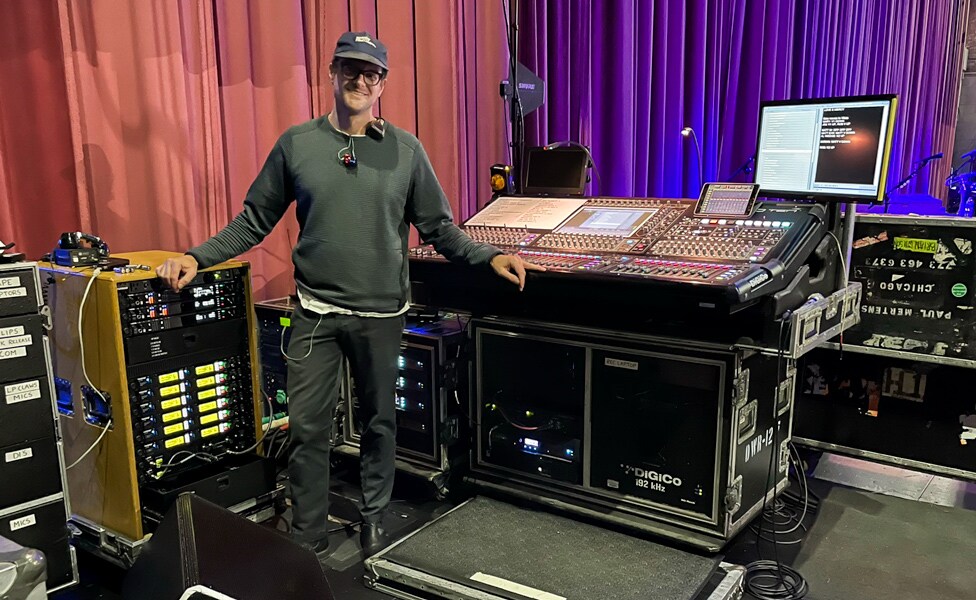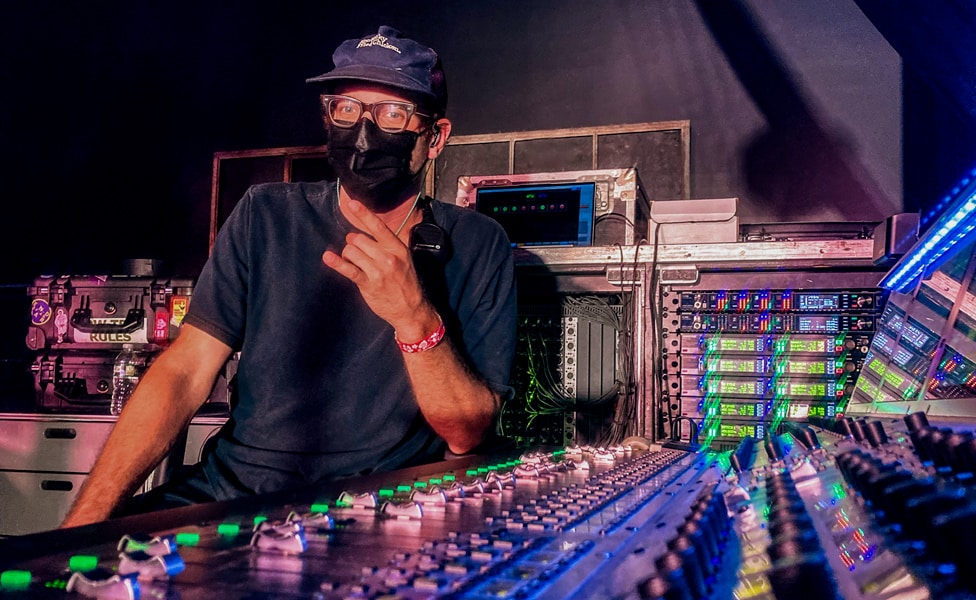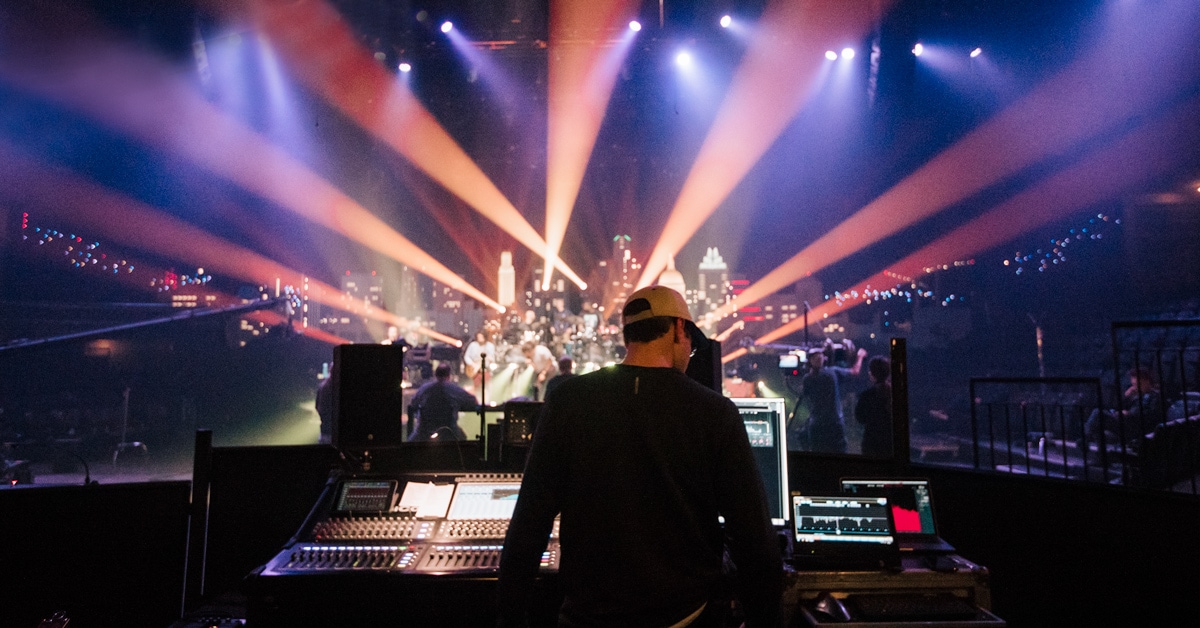Running sound for Black Pumas, The Zombies, Brian Wilson, The Revivalists and many others takes experience, hustle and ingenuity. Michael Pierce has worked as an engineer in nearly every sonic environment imaginable, from historic studios to massive stadiums to tiny SXSW venues. We spoke with him about how he got started, his go-to gear, tips for a great-sounding mix, and how his background as a musician informs his perspective on delivering an excellent sonic experience.
Your career encompasses a variety of experience to deliver great sound—from the studio to beloved Austin venues to your current gig with Black Pumas. Can you walk us through your story?
Michael Pierce: As far as I can tell, this music thing started at birth. I’m from Houston. I started playing drums when I was two years old, on a little Mickey Mouse drum kit. I got a proper kit when I turned eight and kept at it. As a kid, music was my primary mode of exploring the world. I’m an only child and my parents were divorced, so I had to learn to entertain myself. By the time I was in eighth grade, I heard Jimi Hendrix and started teaching myself to play guitar. For about two years, I pretty much only listened to Jimi. Around that time, I got a Digidesign Mbox, remember those? It had a trial version of Pro Tools. I recorded about 120 original songs before I graduated high school.
So, I knew what I wanted to do, and I applied to a bunch of recording schools because I wanted to be able to make music that sounded as good as the albums I liked. I ended up going to USC in L.A. to study audio and the music business. That said, most of what I know about audio I learned on the job in various studios in between ’05 and ’09, at SonyBMG and the Hollywood Bowl, where I saw how large-scale productions build and check. But, I always knew I wanted to live in Austin, so in 2009 I moved here.
My real entrée to the music business happened in late 2009, when I met Damon Lange through a friend. Damon owns a small, boutique live sound company called Nomad Sound, and he became my audio mentor. He seemed to know everyone in Austin, and he seemed to get hired for all the most interesting local events. He was doing shows with [Adrian Quesada’s band] Grupo Fantasma as far back as 2005. Damon had, and still has, a carefully curated warehouse full of great sounding analog audio equipment. These days, Nomad Sound is based in both Austin and Denver, and supplies audio equipment for tours and major festivals nationwide.
While working at Nomad and doing sound at clubs, I kept buying recording gear—mics, keyboards, tape machines, amps—all of which used to be significantly cheaper. I bought a TASCAM 80-8 for $50. I found an Otari MX5050 for $100. I worked with whatever gear I could find. I started playing in a band, making records for fun with my friends, playing house shows and bars around town. Our band was called DUMB. We rejected success in all forms.
My first big touring gig came when Damon recommended me to Chris Tuthill, who manages The Zombies. The Zombies have been one of my favorite bands since I was a kid, so it was very surreal to be hanging out with them. They are like enlightened monks or something in my opinion. Somehow, I’ve managed to build a career entirely through word-of-mouth and reputation. For instance, The Zombies hired Darian Sahanaja from the Brian Wilson Band to play keys for that 2014 Odessey and Oracle tour. I guess Darian recognized my hustle, and years later, when it came time for Brian to hire a new monitor engineer, Darian pushed Brian’s production manager to hire me. At the end of last year’s tour, the band told me it was the smoothest run they’ve had in ten years. Reputation is everything in this business.
Leading up to the pandemic, I was running FOH for The Revivalists, a band from New Orleans. We did some massive shows. I mixed my first arena show at The Forum in L.A. We got to open for the Rolling Stones in Florida. We played all the major American festivals. These were huge gigs and the band had 80 inputs, so there was a lot of complexity and pressure. The Revivalists gig was a great excuse to learn the DiGiCo consoles and broaden my knowledge of Lake and Smaart software. One thing I learned is that in a complex mix, it can be helpful to compress instruments in groups rather than individually. I learned a lot of great tricks mixing those shows. When you’re playing next to other popular bands, the mix becomes a competition for who can sound the best.
Then, things got scary during the pandemic. Honestly, I am very lucky to be doing this work with the Black Pumas. I’ve known Adrian for a while from doing local shows, and when the band hired Nomad to provide audio for a location taping in late 2020, Nomad called me to run sound. That day, I met Kevin O’Halleran and Ryan Matteson from Ten Atoms Management. We clicked during the gig, and things progressed from there.

What are the key differences in getting the music to sound its best in each of these situations—studio, venue you regularly work at, touring with a band?
Pierce: I do a lot of different types of audio work, which means that sometimes my mix is coming out of a large PA system, sometimes it’s reproduced in a mono floor wedge, sometimes on expensive studio monitors. With the Black Pumas, my mix gets reproduced on JH Audio Roxanne in-ear-monitors. I’ve heard of more than a few mastering engineers who check their mixes on Hi-Fi IEMs like these.
Today, live sound systems are so advanced that they can project a near-flat audio spectrum to every seat in the house. Mixing on a nice PA can be a lot like mixing in a studio. Similarly, stage monitors can reproduce a full spectrum at 115dB, within a very focused physical space only in front of the box. The nicer IEMs can reproduce studio-grade sound while reducing outside noise almost entirely. Some audio systems are more capable than others … PA system-teching is a true artform, and I am amazed and inspired by the engineers who design and deploy them. [By the way, there is a huge demand for system-techs in our industry at the moment. A lot of people starting out don’t realize that system-teching is a very viable career. Reach out to a local sound company.]
When I enter a new audio situation, my first goal is to make sure that whoever is listening to my mix will be hearing as full and flat of a spectrum as possible.
In my personal studio, I use Genelec 1081As, because I noticed them in every single mobile recording truck at festivals, and noticed that they were the “B” speaker in a lot of reputable recording studios. After I started using them, my mixes began translating better to small speakers like iPhones and laptops. By now, I know how the Genelecs should sound, and I can tell very quickly if something in a mix is out of place.
I account for changes in live venue sound by measuring the sound of the PA on Smaart software, but in a pinch I can talk into an SM58, and use an EQ to cut offending frequencies. Even when I use the Smaart measurement system, I check the system using my voice because I know that the measurements can be unreliable if they’re set up incorrectly. I know how my voice should sound through an SM58 through any speaker, so I can equalize any speaker to sound natural, insofar as it can reproduce a full (in-phase) audio spectrum. That way, as my mix moves from room to room, the performance sounds consistent because I’m accounting for changes in the sound of each room at the point in the signal chain which varies—i.e. the EQ of the main speaker system, be it a PA, studio monitors, onstage monitors or IEMs.
Using Black Pumas as a recent example—what is your routine when you get to a new venue? What are the top-five things you always do?
Pierce: One, remember as many names as possible: The people I’m working with are definitely the most important part of my day. Doing monitors on tour, I work with new people every day. I don’t talk a ton once I start working, so I try to get to know the crew a bit at the beginning of the day. I make it clear that I’m taking the job seriously, but that I’m not anyone’s boss, and that each person involved has their role and responsibility.
Two, confirm the gear: Got to make sure people brought what they said they would bring, ideally in time for them to send out for anything they’ve forgotten. In the case of the Black Pumas, our monitor rig is a DiGiCo SD12, five Shure PSM1000s and two Axient AD4Qs.
Three, check power: Using a voltmeter at the power distro.
Four, scan the RF environment: I use Shure Wireless Workbench to scan the radio frequency spectrum, to prevent interference with our wireless transmitters.
Five, lunch: This is an easy one to forget but a crucial one to remember.
What do you bring with you on the road—what is your must-have gear for delivering great live sound?
Pierce: The two things I always bring along are my molded JH Audio IEMs and a USB key with the show’s console file. I’m at a point where I feel comfortable working with almost any console. They're all built on the same concepts. Learning a new one is always just a matter of understanding the designer’s intended workflow.
Sometimes people have a healthy budget for a production, an event or a record. Other times they don’t, and you have to work with what’s available. That’s the nature of this type of work, so unfortunately I can’t rely on any specific piece of gear. For live work, I prefer DiGiCo consoles because they can do very complex routing, and they’re very clean sounding. At monitors, I ask for Shure Axient and PSM wireless units. If I’m mixing FOH, I usually tailor the gear to the vibe of the band. For loud rock like The Revivalists, the Empirical Labs Distressor was crucial for getting the lead vocal to pop out of the mix without clipping the meters. With Black Pumas, I need to have a good spring reverb, ideally a few of them. Some plug-ins come close. The Electro-Harmonix Holy Grail will work. But there’s nothing like a real spring. The Demeter RV-1D Real Reverb is a great one. I have another one made by Furman that I love. The only challenge is keeping the subs from rattling the spring unit during the show.
- At Monitors: JH Audio IEMs, DiGiCo SD console, Shure PSM1000’s, Shure Axient
- At FOH: Lake LM44 EQ, Analog or DiGiCo SD console, Empirical Labs Distressor, API 2500+, Outboard reverb if possible
How do venues of different sizes and types change the way you approach your work with Black Pumas?
Pierce: With any artist, it is important to keep the band’s monitor mixes very consistent from show to show, so the musicians can perform consistently. Using IEMs with the Black Pumas allows the band to save their hearing and also hear a lot of detail. The downside is that they are separated from the sound of the room. We generally use a consistent microphone package, so from day to day I am changing the sound of the downstage “ambient” microphones. I change the compression and EQ on those two channels to account for changes in the sound of the room.

How does your experience with Black Pumas in live settings inform how you work with them in the studio?
Pierce: I’m lucky to have developed a rapport with the Black Pumas on tour, so when we’re in the studio, there is a level of trust that hopefully brings comfort to the musicians. Any time I get to work with Aaron [Glemboski] and Adrian [Quesada] at Electric Deluxe, I’m pumped. Adrian has carefully curated his mic and outboard collection, and the stuff sounds beautiful. He just bought a beautiful new tube console. My approach is always to let Adrian lead and try to anticipate the needs of the musicians or other crew in the studio.
Is there a through line with the types/styles/eras of gear they use in the studio versus the stage?
Pierce: Yes, definitely. The Black Pumas have a very specific sound that's rooted in the history of American and Latin American soul music. Fender Princeton amps go a long way to creating that sound, along with Steve Bidwell’s incredible drum arrangements and Adrian’s method of recording and mixing drums. The Electric Deluxe studio, gear-wise, is like a Black Pumas show on steroids—ribbon mics, tube preamps, fantastic sounding analog compressors abound. I wish we could use this type of gear live, but most of it is very fragile. We replicate it as best we can using more durable Beyerdynamic M 160 ribbons and f. We put as many transformers in the signal path as we can, for example the Acme Motown DI WB-3 on bass.
How does your own experience as a musician inform what you do?
Pierce: The foundation of being either a sound engineer or a musician is a passion for listening. I’ve probably listened to more than 100,000 hours of music, and the way I hear has developed significantly over the years.
I genuinely believe that playing in a band makes running sound significantly easier. Having had the experience of playing onstage, an engineer is more likely to be able to anticipate their artists’ needs, and more likely to know when not to make a fader move.
What is your favorite thing about delivering a great-sounding concert?
Pierce: When a show clicks—i.e. the musicians are playing as a group, and the sound and lights are dialed in—there’s a palpable feeling of excitement in the room. That feeling is my favorite part of the show. The Pumas are such a well-rehearsed unit that this happens at almost every show. I love knowing that a large room of people were able to communicate together on a core level. It gives me hope for humanity.
Tips for people who want to do what you do?
Pierce: Try to learn something at every single gig. Even if you don’t learn anything new on a particular gig, this mindset will take you far. It sounds strange, but even wrapping cables can be an art-form if you intend to do it well.
Know your personal values and needs. Touring and studio work involve a lot of long hours, and skipped meals. It’s important to know how you react in situations where your body is lacking fundamental energy.
Say yes, especially at the beginning of a career. When you find folks who inspire you creatively, go out of your way to say yes to any opportunity to work with them. People will recognize anyone who shows up with eagerness and a self-motivated attitude.
Stay flexible. I mean this literally ... do yoga. It’s really easy to get injured moving heavy gear, even in a studio.
Know your worth. This is almost entirely a freelance business, especially on the touring side, so it’s important to develop negotiating skills and know-how to make sure any financial deal is fair for all parties involved. Be honest about your skill level and talk to other engineers about what is fair financially.
Follow what feels interesting or exciting. Jeff Byrd (Black Pumas FOH) really reinforced this principle for me about a year into the pandemic. I needed money, but I was hesitating to do a gig for another band that had a high risk of COVID exposure. He asked me what my reasons were for even considering the gig, and reminded me why I got into doing this type of work. He said that if I wasn’t excited about it, then I shouldn’t do it—simple. It can be easy to lose track of why we’re doing this if money is allowed to become the primary goal. If you can’t be the producer on an album, maybe you can help out and build relationships during a session. If you can’t be the A1 on an interesting show, maybe you can help run cables and acquire some knowledge. If you’re excited about a band playing a club in your area, try buying them a beer and introducing yourself.










